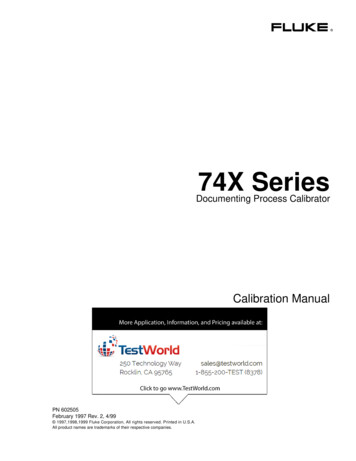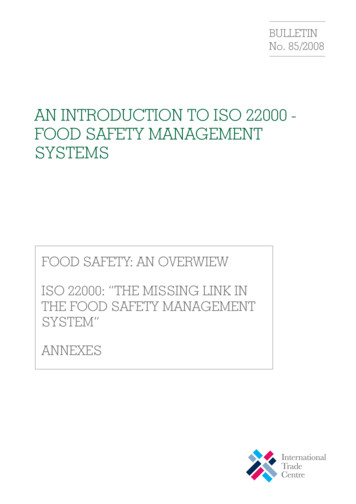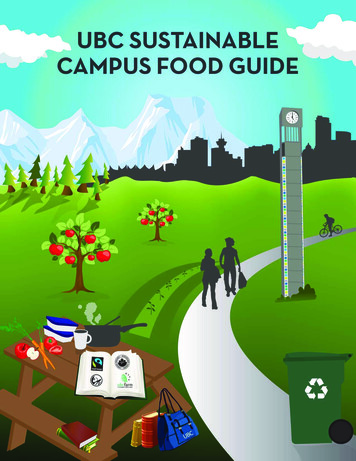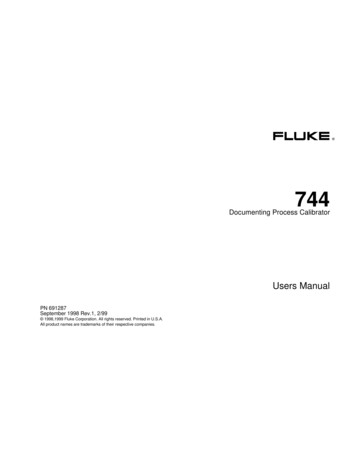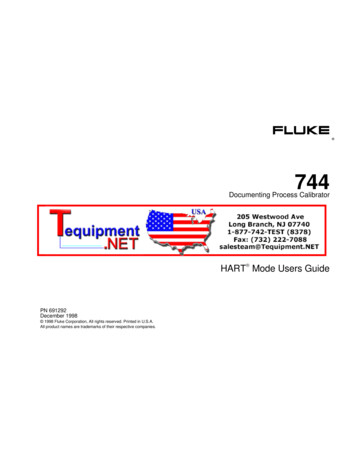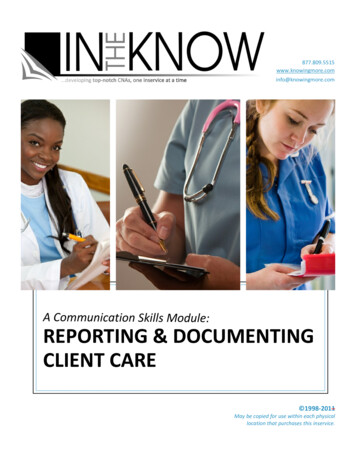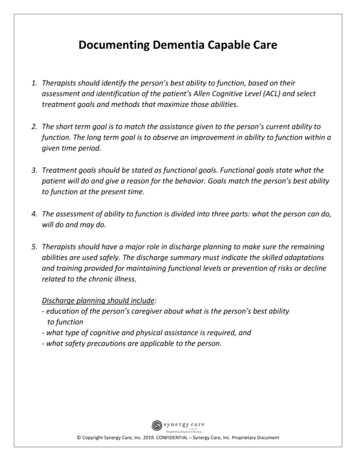
Transcription
DOCUMENTING TRADITIONAL FOOD SYSTEMSOF INDIGENOUS PEOPLES:INTERNATIONAL CASE STUDIESGUIDELINES FOR PROCEDURESHarriet V. Kuhnlein (McGill University, Canada), Suttilak Smitasiri (Mahidol University, Thailand),Salome Yesudas (DDS, Hyderabad, India), Lalita Bhattacharjee (FAO, Bangkok, Thailand),Li Dan (Institute of Nutrition and Food Hygiene, Beijing, China), andSalek Ahmed (UBINIG, Dhaka, Bangladesh)and collaborators:Solot Sirisai, Prapasri Puwastien, Lakana Daoratanahong, and Sakorn Dhanamitta (Mahidol University, Thailand),Fengying Zhai (Institute of Nutrition and Food Hygiene, Beijing, China), P.V. Satheesh (DDS, Hyderabad, India),Gopa Kothari (Child Eye Care Charitable Trust, Mumbai, India), and Farida Akhter (UBINIG, Dhaka, Bangladesh)April 2006
2004 Centre for Indigenous Peoples’ Nutrition and Environment, McGill University, CanadaThis work was carried out with the aid of grants from:International Development Research Centre, Ottawa, CanadaandFood and Agriculture Organization of the United Nations, Rome, Italy.The authors alone are responsible for the views expressed in this document.Review of this procedure by CINE case study participants was made with generous support from theRockefeller Foundation in Bellagio, Italy in 2004.Centre for Indigenous Peoples’Nutrition and EnvironmentMcGill University21,111 Lakeshore RoadSainte-Anne-de-Bellevue, Quebec H9X 3V9CANADAInternational Development Research Centre250 Albert StreetOttawa, Ontario K1G 3H9CANADAFood and Agriculture Organization ofthe United NationsViale delle Terme Caracalla00100 Rome, ITALYCover photos - Top left to right: Dalit millet, Dalit pulses, Bhil meal, Bangladesh laboratory, Karen pile sortBottom, left to right: Nuxalk salmon, Arctic char, Miao greenAll photos in manual: Peter and Lisa Kuhnlein (KP Studios) or Harriet V. KuhnleinLayout and design: HCR Photo2
TABLE OF CONTENTSBackground and credits.6IntroductionIntended readers .9Who are Indigenous Peoples? .9Why have a procedure directed to Indigenous Peoples?.10What is unique about community nutrition work with Indigenous Peoples?.10Short term targets, medium term objectives, and long term goals.11How to use this procedure .11Questions addressed with this procedure .12Overview of timeline, and reporting .13Five Steps to take:Step 1. Prepare the interdisciplinary research team, .15gather background data and develop good participatorytechnique with communities of Indigenous Peoples.Step 2.Gather food list dataTraditional food list .19Traditional food list by season and children/mother likes.20Patterns of traditional food harvest, storage and preparations.20Little-used or currently unused traditional food known by elders .21Market survey for purchased food.23Step 2 Forms.25Step 3. Scientific parameters of traditional foodTaxonomic identifications .37Using the camera .38Selecting and prioritizing food with missing nutrient data.39Identifying good laboratory procedures and costs.40Food sampling, packaging and transport to the laboratory .40Nutrient analysis.42Step 3 Forms.45Step 4. Understanding food use patterns and cultural contextin the community of Indigenous PeopleCard sorts .50Attributes of food suitable for infants and children .51Infant food and feeding.51Children and mothers .52Elders .53Dietary data summary and analysis notes .53Physical health assessments for children 0-12 years .54Step 4 Forms.553
Step 5. Plan for food-based intervention to improve community micronutrient statusReview of food and food use data . 68Environmental advantages and constraints ofkey micronutrient-rich foods in the community . 68The community presentation . 69Working with the community to reach a decisionon the target group segmentation . 69Working with the community to develop and implement the intervention . 70Working with the community to measure outcomes of the intervention. 71Step 5 Forms . 73Preparing the Research ReportData Gathering ToolsKeeping good notes.74Using cameras.79Key informant interviews.80Focus groups and workshops.85Individual interviews (sampling and data procedures) .86Project and community procedures to enhance communication .90Reminders on “do’s and don’ts” for working with Indigenous Peoples .90Working with people who do not have written languagetranslating from local to national languages .92Checklist for a quality food composition laboratory .93References.95Appendices:1. Example of a CINE Community Research Agreement .992. Example of a CINE Indigenous Peoples Collective Research Agreement .1033. Example of a form for Individual Informed Consent.1044. Example traditional food list by season of harvest.1065. Example of a community harvest calendar .1086. Example community food system data table entry .1097. Example guidelines for interviewers .1108. Example food frequency data .1169. Example of 24-hour recall form.11710. Example food composition data table (Dalit) .11911. Example of Process Indicator Form.1214
List of Data Forms for Steps 2-5:FORMS FOR STEP 2:Form 2.1Free List Record Form for Community Food NamesGiven by Individual Key-Informants .25Form 2.2Traditional Food - Complete List from Focus Group/Workshop .26Form 2.3Complete Traditional Food Harvest Calendar and Key Data.27Form 2.4Community Food System Data Tables .28Form 2.5List of Little-Used or Unused Expected Micronutrient Rich Food .30Form 2.6Short list of Expected Key Micronutrient-rich Traditional Foodfor Children and Adults .31Form 2.7Short list of Key Expected Micronutrient Rich Foodwith Notes: Harvest, Process, Storage Techniques .32Forms 2.8Market Survey Table for Children’s Food .33Form 2.9ARank Order of Food Prices for Micronutrient-Rich Market Food Vitamin A .34Form 2.9BRank Order of Food Prices for Micronutrient-Rich Market Food Iron .35Form 2.9CRank Order of Food Prices for Micronutrient-Rich Market Food Vitamin C .36FORMS FOR STEP 3:Form 3.1Sample Herbarium Record Field Label.45Form 3.2Prioritizing Food for Sampling.46Form 3.3List of Samples Targeted for Collection for Nutrient Analysis.47Form 3.4Sample Collection Data Sheet.48FORMS FOR STEP 4:Form 4.1ACard Sort Table for Individuals .55Form 4.1BSummary of Card Sort Responses .56Form 4.2Short List of Expected Key Micronutrient-rich Traditional Food:Taste Scores and Ranks by Children and Adults .57Form 4.3AIndividual Report: Complementary Food Attributes for Infants ( 2 years).58Form 4.3BSummary of Individual Responses on Complementary Food Attributesfor Infants ( 2 years) .59Form 4.4AIndividual Report: Food Attributes for Children (2-12 years) .60Form 4.4BSummary of Individual Responses on Food Attributesfor Children (2-12 years).61Form 4.5Infant Food History (0-2 years) .62Form 4.6Individual 24-hour Recall (Infant, Child, Adult) .64Form 4.7Physical Health Questionnaire for Children 0-12 Years Old .66Form 4.8Key Micronutrient-Rich Food Frequency for Infants, Children and Mothers .67FORMS FOR STEP 5:Form 5.1Decision-making: Summary of Environmental Constraintsand Advantages for Key Micronutrient-Rich Food –Data from Key-Informants and Focus Groups .735
BACKGROUND AND CREDITSThis draft procedure manual was developed with contributions ofmany people. The initial idea for the need for such a document came fromthe work of the Center for Indigenous Peoples’ Nutrition and Environment(CINE) at McGill University, Montreal, where several years of work havedocumented traditional food systems of Indigenous Peoples in Canada.CINE’s methods had foundation in community nutrition studies in WesternCanada, particularly with the Nuxalk Nation in Bella Coola, British Columbia,conducted in the 1980’s. From 1993-2001 CINE professors and staffdeveloped traditional food system assessment methods by working with 46communities of Dene/Metis, Yukon First Nations, and Inuit communities inArctic Canada, which had a foundation in the Nuxalk work. Several of theprocedures included here are modifications of CINE methods, and sometechniques are described from the CINE experience, particularly with regardto participatory research and research agreements. The need to expandCINE’s work into the international arena of Indigenous Peoples was apriority for the CINE Executive and the Governing Board, and noted in theCINE Strategic Plan of 1999. The CINE Governing Board is comprised of 7Aboriginal leadership organizations in Canada: the Assembly of FirstNations, the Council of Yukon First Nations, the Dene Nation, the InuitCircumpolar Conference, the Inuit Tapiriit of Canada, the Metis Nation ofthe Northwest Territories, and the Mohawk Council of Kahnawake. Thecurrent chair of the CINE Board is Chief Bill Erasmus of the Assembly ofFirst Nations.This document is a result of a project with 5 communities ofIndigenous Peoples in Asia. The project was conducted from 2001-2003,and sponsored by the Food and Agriculture Organization of the UnitedNations, Rome, and the International Development Research Centre ofCanada (IDRC). The project is part of the mandate of the current TaskForce of Indigenous Peoples Food and Health of the International Union ofNutritional Sciences (IUNS), of which Harriet Kuhnlein is the chair.A significant predecessor of this manual is a project conductedunder the auspices of the IUNS Committee II-6 from 1992-1994, andpublished in 1997 by the International Nutrition Foundation for DevelopingCountries (INFDC) and the IDRC. The IUNS project was field tested incommunities in China, India, Peru, Philippines and Niger, and addressedculture, environment and food to prevent vitamin A deficiency. It containedguidelines for an ethnographic protocol for the community assessment ofnatural food sources of vitamin A. Special acknowledgement to thecollaborators in this project is given to Dr. Gretel Pelto, Dr. Bert Pelto, andDr. Lauren Blum. In fact, the manual presented here is an adaptation of“the vitamin A procedure” to specifically address traditional food systems ofIndigenous People, with a focus on nutrient composition of traditional food,and the unique environmental and cultural constraints and benefits oftraditional food to address adequate nutrition of several micronutrients incommunities. Several of the exercises and descriptions of methods fromthe earlier works (Blum et al, 1997; Kuhnlein and Pelto, 1997) are adaptedfor use here. Of special note are the qualitative methods for culturaldefinitions of food use including key-informant interviews, how to developCINE Building; Nuxalk Nation inBritish Columbia; Nuxalk books;Vitamin A books; Chief Bill atworkshop; Arctic workshop.6
good communications with communities, and keeping good field notes, alldescribed in the tradition of RAP (rapid assessment procedures). Thecurrent document has expanded sections related to participatory researchwith Indigenous Peoples, field sampling of food for analysis, laboratorymethods, dietary analysis, assessment of environmental constraints andadvantages for Indigenous Peoples, and planning food-based interventions.Within the United Nations agencies, the Food and AgricultureOrganization documented the need for development of this procedure andits application to Indigenous Peoples at the Workshop on Food Insecurityand Vulnerability Information Mapping Systems (FIVIMS) held in Bangkok inNovember, 2000. As well, the World Health Organization expressedinterest through its Health of Indigenous Peoples section, as part ofactivities during the Decade for Indigenous Peoples. Interest was alsoexpressed from United Nations conventions on Human Rights and BiologicalDiversity.The need for case studies to apply the procedure was obvious.Therefore, case study teams were developed for representative IndigenousPeople in one regional area, Asia, where there are many indigenous culturalgroups in diverse environmental settings. Case study teams met in aworkshop to discuss methods in Salaya, Thailand, March 12-16, 2001,which resulted in this draft.Case studies which developed were:1. the Karen of Thailand, with team members lead by Dr. SuttilakSmitasiri, Dr. Prapasri Puwastein, Mr. Solot Sirisai, and Dr. LakanaDaoratanahong;2. the Miao of Sichuan, China, with team members led by Dr. Li Dan andDr. Fengying Zhai;3. the Bhils of Gujarat, India, with team members led by Dr. Gopa Kothariand Dr. Lalita Bhattacharjee4. Nayakrishi farmers, including the Mogh of Makeshkhali Island,Bangladesh, with team members led by Ms. Farida Akhter and Dr. SalekAhmed; and5. Dalit farmers of Zaheerabad area, Medak district of Andhra Pradesh,South India, with team members led by P.V. Satheesh and Ms. SalomeYesudas.The Salaya workshop was directed by Dr. Harriet Kuhnlein, withlogistical support from Dr. Suttilak Smitasiri and the Institute of Languageand Culture for Rural Development, and the Institute of Nutrition at MahidolUniversity. Funding was provided by the Food and Agriculture Organizationof the United Nations (Regional Area of Asia and the Pacific), theInternational Development Research Centre (Canada), and CINE. Twovisits to the Karen area were made in conjunction with the workshop: oneto witness a special ceremony to celebrate the forest in which the Karen ofSanepong and other communities live; and a second to introduce Chief BillErasmus (National Chief of the Dene Nation at that time and Chair of theCINE Governing Board) to Karen leaders in Sanepong and Kanchanaburi,Thailand.Salaya workshop participants;Salaya workshop; Bhil community;Mogh community; Miaoparticipants.7
In addition to those noted above, special thanks are given to thefollowing major contributors who developed the plan and the proceduresduring the Salaya workshop: Dr. Biplab Nandi (FAO Regional Office for Asiaand the Pacific in Bangkok), Dr. Lakana Daoratanahong (Institute ofLanguage and Culture for Rural Development, Mahidol University), Dr.Pongtorn Sungpuag (Institute of Nutrition, Mahidol University (INMU)), Mrs.Orapin Bangong (INMU), Ms. Sopa Tamaehotipang (INMU), Mr. JaraySadakorn (Bangkok Herbarium), Dr. Opart Panya (Faculty of Environment,Mahidol University), Mr. Alongkot Chukaew (Wildlife conservation specialist),Ms. Siri Damman (International Program for the Right to Food inDevelopment, University of Oslo), Ms. Benjamas Chumvorratayee (SanepongVillage), Mr. Sompop Sungklachalatarn (Karen leader, Sanepong Village),Mr. Bundid Grivijitr (Education specialist, Sanepong Village), (Ms. SineeChotiboriboon (INMU) and Ms. Prapa Kongpunya (INMU), Dr. EmornWasantwisut (INMU), Dr. Sakorn Dhanamitta (INMU) and staff of theDivision of Communication and Behavioral Sciences at INMU.We also thank those contributing to final preparation of thisdocument. In particular, Kristin Rindress and Helen Rimmer of McGillUniversity are thanked for work on the final draft. We also acknowledgethose contributing revisions at the workshop held in Rome, 2002.The procedures are suitable for application to other case studies inthe global environment, including North America, Africa, South America,Australia, and other Asian areas. It is anticipated that further refinementswill be developed to improve this version.8
INTRODUCTIONIntended readersThis procedure is intended for all who have particular interest in thefood, nutrition and health of Indigenous Peoples. The text and variouselements of the procedure appropriate for study of traditional food systemsof all Indigenous Peoples, with special relevance to Indigenous Peoples inthe Americas and Asia, from where contributing experts have been drawn.The intended users of the procedure are expected to be experiencedhealth professionals, with interests and experience in food-based strategiesfor nutrition promotion programs.The assessment described here has the purpose to provideessential information for developing better micronutrient nutrition incommunities of Indigenous Peoples, and to lead to appropriate food-basedinterventions where they may be needed. The case study areas wereselected with recognition that the natural environment, if still basicallyintact, is capable of contributing a complete diet within the traditions of thepeople living in it. Knowledge derived from these assessments cantherefore be applied to other communities of Indigenous People within thesame culture and environment context of those described here. Theprocedures can be broadly applied.This assessment is not intended to generate information forindustrial exploitation of natural environments within which IndigenousPeoples live. Rather, it is a procedure blending traditional knowledge andlaboratory science information which can most appropriately be applied byIndigenous Peoples themselves to their own circumstances to improvecommunity nutrition and health using traditional food resources.Who are Indigenous Peoples?A succinct working definition of Indigenous Peoples for the purposesof this project is: ‘Indigenous people’ refers to a cultural group in aparticular ecological area that developed a successful subsistance base fromthe natural resources available. The plural form, ' Indigenous Peoples',refers to more than one cultural group. Under International Law, and byUnited Nations bodies, Indigenous Peoples are distinguished byresidence within or attachment to geographically distincttraditional habitats, ancestral territories, and naturalresources in these habitats and territories; maintenance of cultural and social identities, and social,economic, cultural and political institutions separate frommainstream or dominant societies and cultures; descent from population groups present in a given area,most frequently before modern states or territories werecreated and current borders defined; self-identification as being part of a distinct indigenouscultural group, and the display of desire to preserve thatcultural identity. Bhil women; Bhil samples collected;Miao participants; Nayakrishi home,Bangladesh; Nuxalk salmonbarbeque.9
Self-identification as indigenous or tribal is usually regarded as afundamental criterion for determining indigenous or tribal groups,sometimes in combination with other variables such as language spokenand geographic location or concentration. (UNDP, 2000)Why have a procedure targeted to Indigenous Peoples?Universally, within communities of Indigenous Peoples, there is theknowledge of the natural resources that make up the food environment.Capacity-building to use this knowledge for contemporary nutrition andhealth promotion of these people is well-received. At the same time,Indigenous Peoples face potential loss of this knowledge due to lack of useby younger members of the society and to gradual loss of elder memberswho know the most about the resources. Thus, it is important to implementuse of this knowledge soon. Additionally, Indigenous Peoples are often themost disenfranchised and poorest members of the larger society or nation,and they are targeted by most governments for health improvement anddevelopment. However, it has been shown that development often leadsto trends in dietary change that lead to increasing risk of chronic diseasesuch as obesity and diabetes. This unfortunate consequence ofdevelopment can be moderated with increased attention to the principles ofdiet and health already contained within the culture, and with recognitionof the nutrient properties of traditional food resources, these local foodscan be used to their best advantage for health promotion.Concerns with environmental protection of food biodiversity alsolead to understanding the need for close work with Indigenous Peoples.Many species of both plants and animals are threatened with extinction dueto environmental deterioration of their habitats in forests and other fragileecosystems. Indigenous cultures around the world are being disrupted anddestroyed for the same reasons, especially since economic agricultural andhealth/nutritional conditions of these people depend on their local foodresources. In fact, native peoples have been the stewards of 99% of theworld’s genetic resources, and the inextricable link between cultural andbiological diversity which cannot be ignored can lead to protection of thesefood resources for all humankind.What is unique about community nutrition work with IndigenousPeoples?Community nutritionists who work with Indigenous People, and whoare not part of the local indigenous culture, always face the requirement towork cross-culturally. Not only are the targeted people usually fromanother culture, but they face issues of assimilation by a larger culture.Understanding and sensitivity to these issues and maintaining knowledgeand respect for local traditions and lifestyles is paramount to success inhealth promotion efforts with Indigenous Peoples. Issues in environmentalprotection, and availability of land for food purposes are often politicallysensitive areas of which health professionals must be appraised, and whichaffect knowledge areas key to the procedure, but which are betteraddressed through different channels. Finally, there are important andfascinating lessons to be learned about unique food species and their place10
in a traditional food system.Procedures to compensate Indigenous Peoples for the utilization oftheir knowledge of their biological food resources are expected to beunique. Often, the most salient compensation is development of educationand action programs for the youth of these communities so they may havefuture access to these resources. In addition, most Indigenous Peopleswelcome the opportunity to alert the global community to the value ofindigenous knowledge. Local knowledge regarding conservation,management and sustainable utilization of food resources should berecorded and duly recognized.Short term targets, medium term objectives, and long term goalsThe short term target addressed in this book is development of auseable procedure for understanding and documenting the traditional foodsystem of Indigenous People, and publishing this under the auspices of theFAO and IDRC. Cases studies in the Asian region were selected to build amodel, understanding parameters of the food diversity within a broadgeographical region, and also so that the case studies could assist eachother and make use of existing nutrient data in neighboring areas. Themost significant medium term objectives for which this procedure isspecifically intended is to derive from the knowledge gained a successfulfood-based intervention that improves health of Indigenous People withinthe same culture and environmental setting. Long term goals are toexpand this procedure and health promotion efforts using traditional food tomany communities of Indigenous Peoples worldwide.How to use this procedureThe steps in this manual lead to achieving interrelated milestonestoward the short term and medium term targets and objectives; that is, tobuild the knowledge of food as consumed in communities of IndigenousPeople that will lead to a successful food-based health promotion strategy.The five component parts are:1. Prepare the interdisciplinary research team, gatherbackground data and develop good participatorytechnique with communities of Indigenous Peoples.2. Gather food list data, including seasonality, preparations,suitability for children, etc.3. Gather the scientific parameters of traditional food,including taxonomic identifications, laboratory evaluationand compilation of nutrient composition.4. Understand dietary food use and nutrient intake patternsand cultural context in the community of IndigenousPeople, particularly for infants, children, mothers andelders.11
5. Plan for food-based intervention to improve community micronutrientstatus within the environmental and cultural context of thecommunity, and document success.This manual assists with identification of the research questions, andhow to collect the data to address them. Please see the Table of Contentsto find specific procedures for each component step. Descriptions of datagathering tools and examples of data presentation are given at the end ofthe document.QUESTIONS ADDRESSED WITH THIS PROCEDUREMain questions: Can the traditional food system be used toimprove micronutrient status of the community? Can the negativeeffects of the nutrition transition (obesity, poor quality diet) beprevented or reversed?1. What foods are contained in the complete traditional foodlist of the cultural group under study? How are theseidentified by local names and scientific nomenclature,including listing of varieties of food frequently used.2. What is the seasonality and frequency of use of eachfood? How are the most often used foods ranked for yearround quantity of consumption by the community as awhole?3. What are the 25-30 key foods that are likely to providemicronutrients?What are the best foods in thecommunity that prevent protein-energy malnutrition?
Therefore, case study teams were developed for representative Indigenous People in one regional area, Asia, where there are many indigenous cultural groups in diverse environmental settings. Case study teams met in a workshop to discuss methods in Salaya, Thailand, March 12-16, 2001, which r
